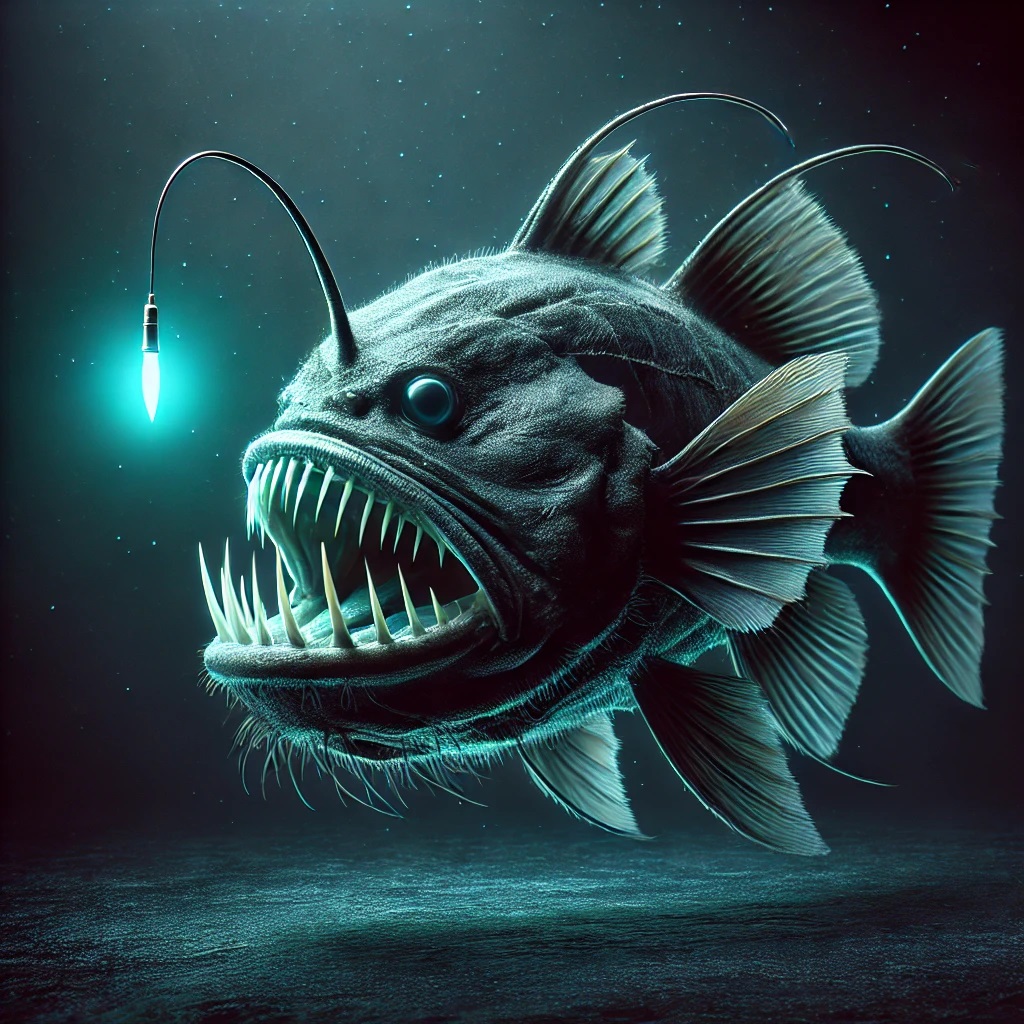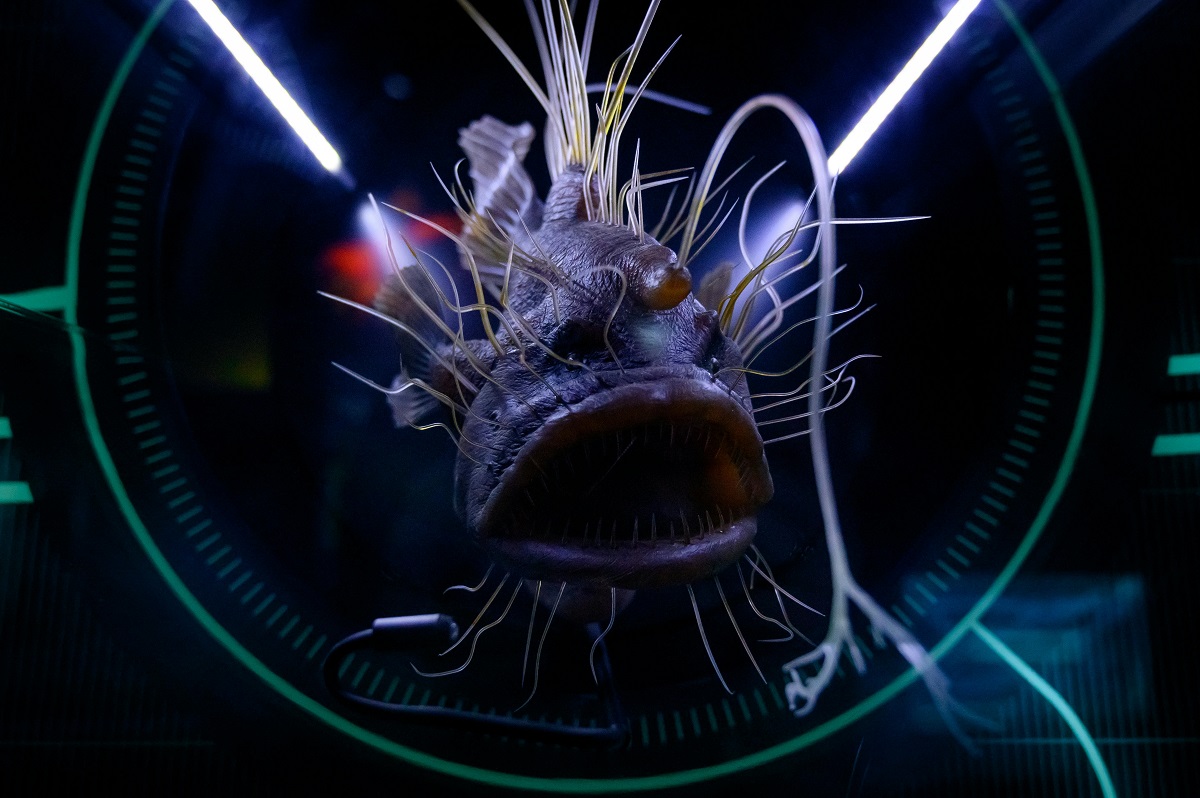The anglerfish is one of the most fascinating creatures in the ocean. It lives in the deep, dark parts of the sea and is known for its unique hunting method. It has a special lure that glows in the dark, which helps it catch prey. The anglerfish is a master of survival in the deep sea. Let’s dive into the world of this mysterious fish.
What is an Anglerfish?
| Category | Details |
|---|---|
| Common Name | Anglerfish |
| Scientific Name | Order: Lophiiformes (includes over 200 species) |
| Class | Actinopterygii (ray-finned fishes) |
| Family | Multiple families, including Ceratiidae, Linophrynidae, and Melanocetidae |
| Habitat | Deep sea (200–2,000 meters or more below the surface) |
| Distribution | Atlantic, Antarctic, Pacific, and Indian Oceans |
| Size | Females: 20 cm to 1 meter (depending on species); Males: Much smaller (2–3 cm) |
| Weight | Females: Up to 50 kg; Males: Less than 1 kg |
| Lifespan | Unknown in the wild; estimated to be several years |
| Diet | Carnivorous (fish, crustaceans, squid) |
| Unique Features | Bioluminescent lure (esca), large mouth, sharp teeth, sexual dimorphism |
| Reproduction | Sexual; males fuse to females for life (parasitic mating) |
| Conservation Status | Not evaluated (most species); deep-sea habitats are poorly studied |
| Predators | Few natural predators; occasionally larger deep-sea fish |
| Adaptations | Slow metabolism, bioluminescence, flexible body for high-pressure survival |
Anglerfish are a type of fish that lives in the deep ocean. There are over 200 species of anglerfish, which belong to the order Lophiiformes. These fish are found in different parts of the world, including the Atlantic and Antarctic oceans, and some species also live in the Pacific and Indian oceans.
Anglerfish are known for their strange appearance. They have large heads and big mouths. Their bodies are often round and bulky. They have sharp teeth that point inward. This helps them catch and hold onto their prey. The most striking feature of the anglerfish is its lure. This lure is a modified fin that grows from the top of its head.
The Deep Sea Habitat

Anglerfish live in the deep sea. This is one of the most extreme environments on Earth. The deep sea is cold, dark, and has high pressure. Sunlight does not reach these depths. The water is completely black. The pressure can crush most animals. But the anglerfish is well adapted to this environment.
The deep sea is also a place of mystery. Scientists have explored only a small part of it. Many creatures in the deep sea are still unknown. The anglerfish is one of the few deep-sea creatures that has been studied. But there is still much to learn about it.
The Anglerfish’s Lure
The anglerfish’s lure is its most famous feature. This lure is called the esca. It is a fleshy growth at the end of a long spine. The spine is called the ilium. The escalator glows in the dark. This glow is called bioluminescence. It is created by tiny bacteria that live inside the esophagus.
The anglerfish uses its lure to attract prey. It wiggles the lure to make it look like a small fish or shrimp. When a predator comes close, the anglerfish strikes. It opens its large mouth and swallows the prey whole. The sharp teeth ensure that the prey cannot escape.
The lure is also used for communication. Some species of anglerfish use their lures to attract mates. The glow of the lure can be seen from far away. This helps the fish find each other in the dark ocean.
Hunting and Diet
The anglerfish is a carnivore. It eats other fish, crustaceans, and squid. It is an ambush predator. This means it waits for its prey to come close. Then it attacks quickly. The anglerfish does not chase its prey. It relies on its lure to bring the prey to it.
The anglerfish has a large mouth. It can swallow prey that is almost as big as itself. Its stomach can expand to hold large meals. This is important in the deep sea. Food is scarce in this environment. The anglerfish must eat as much as it can when it finds food.
Reproduction
The reproduction of the anglerfish is one of the most unusual in the animal kingdom. In many species, the male and female are very different. The female is much larger than the male. The male is tiny and often looks like a different species.
When a male anglerfish finds a female, he bites into her skin. He then attaches himself to her body. Over time, the male’s body fuses with the female’s. He becomes a permanent part of her. The male’s organs, except for his testes, degenerate. He becomes a source of sperm for the female.
This strange behavior ensures that the female always has a mate. In the deep sea, finding a mate is difficult. The male’s attachment to the female solves this problem. The female can produce eggs whenever she is ready. The male provides the sperm to fertilize the eggs.
Adaptations to the Deep Sea
The anglerfish has many adaptations for life in the deep sea. Its body is designed to survive in extreme conditions. The high pressure of the deep sea would crush most animals. But the anglerfish’s body is flexible. It can withstand the pressure.
The anglerfish also has a slow metabolism. This means it does not need much food to survive. In the deep sea, food is scarce. The anglerfish can go for long periods without eating. When it does find food, it eats as much as it can.
The anglerfish’s eyes are small. In the dark ocean, eyes are not very useful. The anglerfish relies more on its sense of smell and its lure. Its sense of smell helps it detect prey from a distance. The lure helps it attract prey close enough to catch.
Bioluminescence
Bioluminescence is common in the deep sea. Many deep-sea creatures can produce light. The anglerfish’s lure is one example of bioluminescence. The light is produced by bacteria that live in the esca. These bacteria have a symbiotic relationship with the anglerfish. The bacteria get a safe place to live. The anglerfish gets a glowing lure.
Bioluminescence is used for many purposes in the deep sea. It can be used to attract prey, like in the anglerfish. It can also be used to communicate. Some animals use bioluminescence to confuse predators. They release a cloud of glowing liquid. This distracts the predator and allows the animal to escape.

